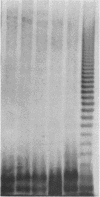Abstract
In a previous study, we found that some O serotypes of Serratia marcescens, as defined by agglutination tests, were not based on lipopolysaccharide (LPS) O antigens. We developed a dot enzyme immunoassay with a high degree of LPS specificity and tested 104 distinct clinical strains. Only 7 of the 24 existing O antigens were found in more than one strain: O12/O14 (30.8% of strains examined), O21 (12.5%), O8 (8.7%), O6/O7 (5.8%), O4 (3.8%), O18 (2.9%), and O9 (2.9%). Two new antigens, S1254 (13.5%) and S3255 (3.8%), were also found. Agglutination tests with O antisera identified the LPS antigen in only 36 strains. Prodigiosin production was restricted to serotypes O8, O6, and S3255 and strains with a rough or semirough LPS phenotype. Dot immunoassay appears to offer greater accuracy than agglutination tests for serotype identification in S. marcescens.
Full text
PDF



Images in this article
Selected References
These references are in PubMed. This may not be the complete list of references from this article.
- Gaston M. A., Pitt T. L. O-antigen specificities of the serotype strains of Serratia marcescens. J Clin Microbiol. 1989 Dec;27(12):2697–2701. doi: 10.1128/jcm.27.12.2697-2701.1989. [DOI] [PMC free article] [PubMed] [Google Scholar]
- Grimont P. A., Grimont F., Le Minor S., Davis B., Pigache F. Compatible results obtained from biotyping and serotyping in Serratia marcescens. J Clin Microbiol. 1979 Oct;10(4):425–432. doi: 10.1128/jcm.10.4.425-432.1979. [DOI] [PMC free article] [PubMed] [Google Scholar]
- Hitchcock P. J., Brown T. M. Morphological heterogeneity among Salmonella lipopolysaccharide chemotypes in silver-stained polyacrylamide gels. J Bacteriol. 1983 Apr;154(1):269–277. doi: 10.1128/jb.154.1.269-277.1983. [DOI] [PMC free article] [PubMed] [Google Scholar]
- Hunter P. R., Gaston M. A. Numerical index of the discriminatory ability of typing systems: an application of Simpson's index of diversity. J Clin Microbiol. 1988 Nov;26(11):2465–2466. doi: 10.1128/jcm.26.11.2465-2466.1988. [DOI] [PMC free article] [PubMed] [Google Scholar]
- Laemmli U. K. Cleavage of structural proteins during the assembly of the head of bacteriophage T4. Nature. 1970 Aug 15;227(5259):680–685. doi: 10.1038/227680a0. [DOI] [PubMed] [Google Scholar]
- Muto Y., Tsuji A., Kaneko Y., Goto S. Relationship between pigment producibility and drug resistance in Serratia marcescens. Microbiol Immunol. 1981;25(11):1101–1108. doi: 10.1111/j.1348-0421.1981.tb00118.x. [DOI] [PubMed] [Google Scholar]
- Tsai C. M., Frasch C. E. A sensitive silver stain for detecting lipopolysaccharides in polyacrylamide gels. Anal Biochem. 1982 Jan 1;119(1):115–119. doi: 10.1016/0003-2697(82)90673-x. [DOI] [PubMed] [Google Scholar]




